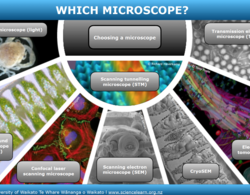Function: Lets users build up a 3D model of a sample from TEM data.
Maximum magnification: Approximately 5,000,000x.
Best for:
Understanding relationships between objects in a sample at high resolution.
Understanding three-dimensional structure.
Looking at objects in very high resolution.
Disadvantages:
Can’t be used to look at living things (samples need to be prepared extensively before visualising).
Video: Allan Mitchell, Technical Manager of Otago Micro and Nanoscale Imaging, explains how electron tomography uses an electric beam to build an image in 3D. Watch Electron tomography of the primary cilium to see why Associate Professor Tony Poole utilised electron tomography for his research.
Transcript
Allan Mitchell
The technique that allows us to make 3D models of our biological structures is called electron tomography. If you imagine that this book is the section that we use for electron tomography and it’s thicker than a normal section would be, we place this section inside the microscope and then, while illuminating with our electron beam, we start to tilt it. We take an image at 1° tilt, 2° tilt, 3° tilt, and in this way, the electron beam is building data that is through the thickness of the sample rather than data that is superimposed over the top of each other.
The information looks very, very confused. However, with special computer programs, we can take that confused information and put that image back into its three-dimensional space, and we end up with a three-dimensional model of what we were looking at.
Acknowledgements
Allan Mitchell, University of Otago
Associate Professor Tony Poole, University of Otago
Mike Jennings, University of Otago


